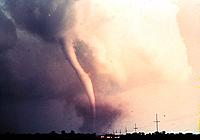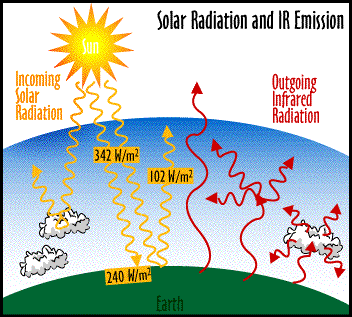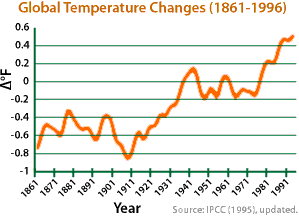
Global
Climate Change: Overview
 Global
climate change is a change in the long-term weather
patterns that characterize the regions of the world. The term
"weather" refers to the short-term (daily)
changes in temperature, wind, and/or precipitation of a region
(Merritts et al. 1998). Weather is influenced by the sun. The sun
heats the earth's atmosphere and its surface causing air and
water to move around the planet. The result can be as simple as a slight
breeze or as complex as the formation of a tornado (see above). Photo:
The first tornado captured by the National Severe Storms Laboratory Doppler
radar in Union City, Oklahoma on May 24, 1973. Photo courtesy of National
Oceanic and Atmospheric Administration.
Global
climate change is a change in the long-term weather
patterns that characterize the regions of the world. The term
"weather" refers to the short-term (daily)
changes in temperature, wind, and/or precipitation of a region
(Merritts et al. 1998). Weather is influenced by the sun. The sun
heats the earth's atmosphere and its surface causing air and
water to move around the planet. The result can be as simple as a slight
breeze or as complex as the formation of a tornado (see above). Photo:
The first tornado captured by the National Severe Storms Laboratory Doppler
radar in Union City, Oklahoma on May 24, 1973. Photo courtesy of National
Oceanic and Atmospheric Administration.
Some of the sun's incoming long wave radiation is reflected back to space by aerosols. Aerosols are very small particles of dust, water vapor, and chemicals in Earth's atmosphere. In addition, some of the sun's energy that has entered Earth's atmosphere is reflected into space by the planet's surface. The reflectivity of Earth's surface is called albedo. Both of these reflective processes have a cooling affect on the planet.
The greenhouse effect is a warming process that balances Earth's cooling processes. During this process, sunlight passes through Earth's atmosphere as short-wave radiation. Some of the radiation is absorbed by the planet's surface. As Earth's surface is heated, it emits long wave radiation toward the atmosphere. In the atmosphere, some of the long wave radiation is absorbed by certain gases called greenhouse gases. Greenhouse gases include carbon dioxide (CO2), Chlorofluorocarbons (CFC's), methane (CH4), nitrous oxide (N20), tropospheric ozone (O3), and water vapor. Each molecule of greenhouse gas becomes energized by the long wave radiation. The energized molecules of gas then emit heat energy in all directions. By emitting heat energy toward Earth, greenhouse gases increase Earth's temperature. Note that the warning mechanism for the "greenhouse effect" is NOT exactly the same as the warning mechanism of greenhouse walls. While greenhouse gases absorb long wave radiation then emit heat energy in all directions, greenhouse walls physically trap heat inside of greenhouses and prevent it from escaping to the atmosphere.
The greenhouse effect is a natural occurrence that maintains Earth's average temperature at approximately 60 degrees Fahrenheit. The greenhouse effect is a necessary phenomenon that keeps all Earth's heat from escaping to the outer atmosphere. Without the greenhouse effect, temperatures on Earth would be much lower than they are now, and the existence of life on this planet would not be possible. However, too many greenhouse gases in Earth's atmosphere could increase the greenhouse effect. This could result in an increase in mean global temperatures as well as changes in precipitation patterns.

The real threat of climate change lies in how rapidly the change occurs. For example, over the past 130 years, the 7mean global temperature appears to have risen 0.6 to 1.2 degrees Fahrenheit (0.3 to 0.7 degrees Celsius). These temperatures changes are depicted in the graph below from the EPA's Global Warming site. The increasing steepness of the curve suggests that changes in mean global temperature have occurred at greater rates over time. Further evidence suggests that future increases in mean global temperature may occur at a rate of 0.4 degrees Fahrenheit (0.2 degrees Celsius) each decade. Figure: Changes in global temperature (degrees Fahrenheit) from 1861 to 1996. Graph adapted from image courtesy of the U.S. EPA.
 The geological record--the
physical evidence of the results of processes that have occurred on
Earth
since it was formed--provides evidence of climate changes similar in magnitude to those
in the the above graph. This means during the history of the earth,
there have been changes in global temperatures similar in size to these
changes. However, the past changes occurred at much slower rates, and thus
they were spread out over long periods of time. The slow rate of change
allowed most species enough time to adapt to the new climate. The current
and predicted rates of temperature change, on the other hand, may be
harmful to ecosystems. This is because these rates of temperature change
are much faster than those of Earth's past. Many species of plants,
animals, and microorganisms may not have enough time to adapt to the new
climate. These organisms may become extinct. Figure:
Global temperature (degrees F) changes from 1861 to 1996. Graph adapted
from image courtesy of the U.S. EPA.
The geological record--the
physical evidence of the results of processes that have occurred on
Earth
since it was formed--provides evidence of climate changes similar in magnitude to those
in the the above graph. This means during the history of the earth,
there have been changes in global temperatures similar in size to these
changes. However, the past changes occurred at much slower rates, and thus
they were spread out over long periods of time. The slow rate of change
allowed most species enough time to adapt to the new climate. The current
and predicted rates of temperature change, on the other hand, may be
harmful to ecosystems. This is because these rates of temperature change
are much faster than those of Earth's past. Many species of plants,
animals, and microorganisms may not have enough time to adapt to the new
climate. These organisms may become extinct. Figure:
Global temperature (degrees F) changes from 1861 to 1996. Graph adapted
from image courtesy of the U.S. EPA.
Overview
..|..
Human Influences ..|..
Impacts
Glossary ..|..
Related
Links ..|..
References
|..
PBL
Model
Home ..|.. Teacher Pages ..|.. Modules & Activities
HTML code by Chris
Kreger
Maintained by ETE
Team
Last updated November 10, 2004
Some images © 2004 www.clipart.com
Privacy Statement and Copyright © 1997-2004 by Wheeling Jesuit University/NASA-supported Classroom of the Future. All rights reserved.
Center for Educational Technologies, Circuit Board/Apple graphic logo, and COTF Classroom of the Future logo are registered trademarks of Wheeling Jesuit University.
